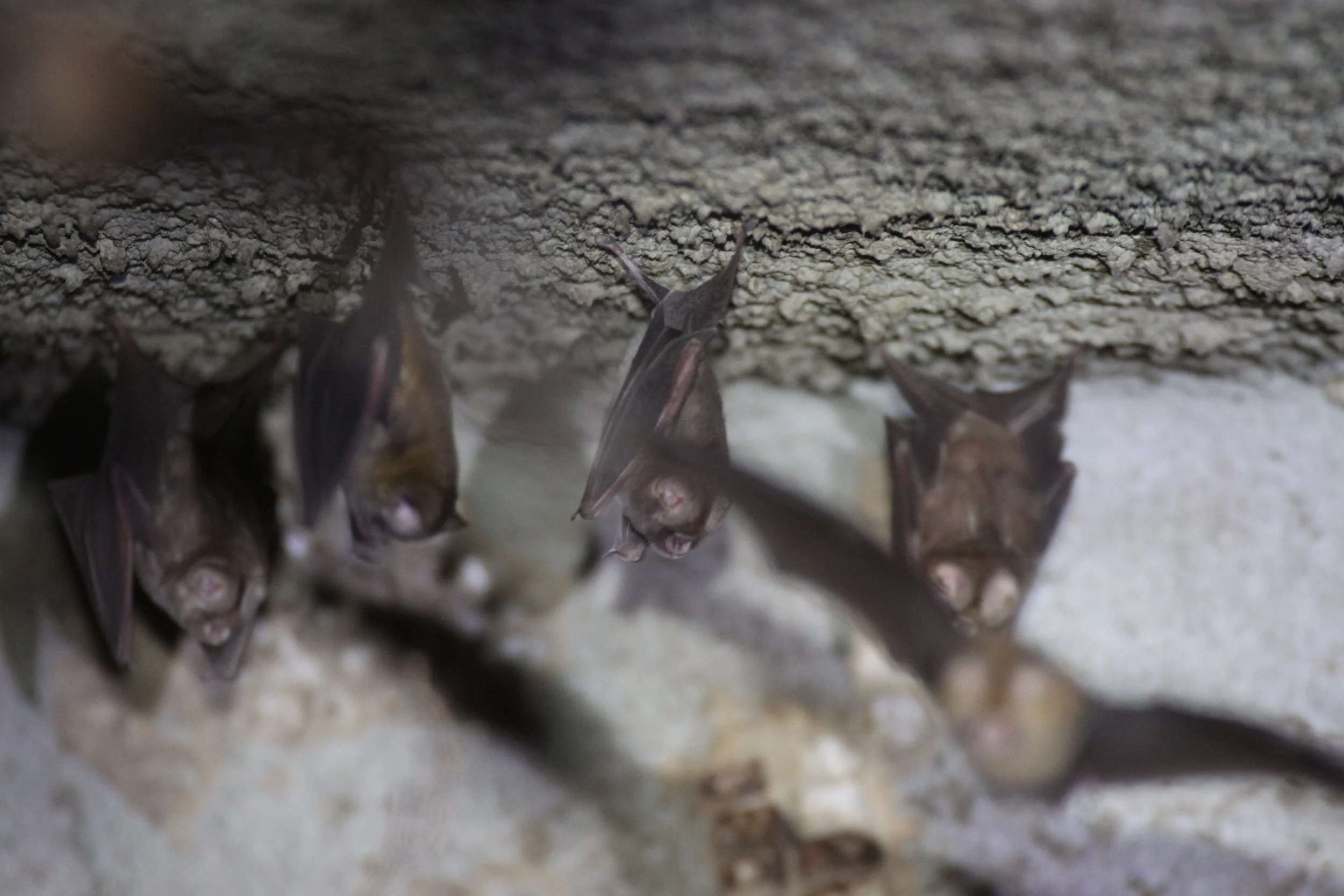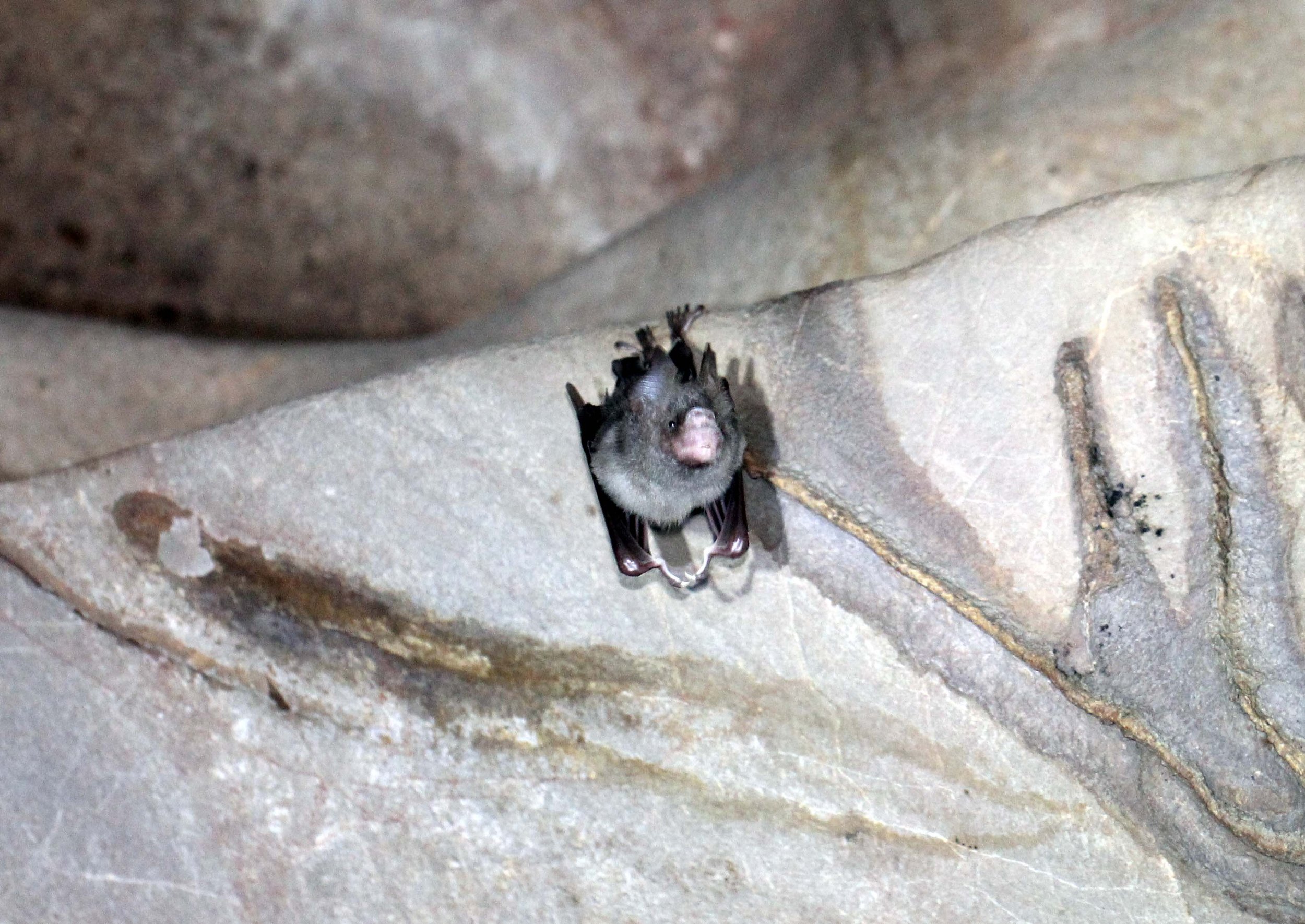
Genus Hipposideros the Roundleaf Bats
The Bicolored Roundleaf Bat (Hipposideros bicolor)
Sundevall's roundleaf bat (Hipposideros caffer)
Fawn-leaf Roundleaf Bat (Hipposideros cervinus)
Ashy Large-eared Roundleaf Bat (Hipposideros cineraceus) Shield-faced Roundleaf Bat (Hipposideros lylei)
Cantor's roundleaf bat (Hipposideros galeritus)
Bicolored Roundleaf Bat (Hipposideros bicolor)
The Bicolored Roundleaf Bat (Hipposideros bicolor) is a species of bat in the family Hipposideridae found in Indonesia, Malaysia, the Philippines, Thailand, and Timor-Leste. This bat inhabits caves, rock crevices and tunnels among lowland forests. They roost in large numbers and consume mostly small winged insects. Their navigation and hunting skills come from the use of echolocation. Its leafnose is used to release ultrasonic shouts to distinguish its surroundings. Echolocation is also used to distinguish other species based on their wingbeat and size. The habitat of this bat decides the color of its fur. Bleaching fumes of a cave environment will cause an orange colored fur. Those who inhabit a well-ventilated roost will be a light brown color.
It was described as a new species in 1834 by Dutch zoologist Coenraad Jacob Temminck. Temminck placed it in the genus Rhinolophus with a binomial of R. bicolor. The bicolored leafnose bat has four subspecies: Hipposideros bicolor atrox, Hipposideros bicolor major, Hipposideros bicolor bicolor and Hipposideros bicolor erigens.
In West Malaysia, researchers have found two different groups of bicolored roundleaf bats. These seemingly identical groups are distinguished by their size and echolocation frequency. The first group has a more rounded wingtip due to its smaller weight and shorter wider wing. It also has an echolocation call between 127.0 and 134.4 kilohertz. The second group has a smaller tibia length but weighs more with larger wings. Their echolocation call ranges from 138.0 to 144.0 kilohertz. Researchers conclude that the first group's body composition may be more suited for better flight agility and hunting in cluttered spaces.
The bicolored roundleaf bat is found in Southeast Asia where its range includes Indonesia, Malaysia, the Philippines, Thailand, and Timor-Leste. It has been documented at elevations up to 600 m (2,000 ft) above sea level. Hipposideros bicolor atrox is documented in southern Thailand to Sumatra. Hipposideros bicolor major located in Enggano Islands and Nias. Hipposideros bicolor bicolor inhabits in Java stretching to the Lesser Sunda Islands and Borneo. Hipposideros bicolor erigens lives solely in the Philippines.
Bicolored Roundleaf Bat (Hipposideros bicolor) Koh Lanta Island Thailand



Sundevall's roundleaf bat (Hipposideros caffer)
Sundevall's roundleaf bat (Hipposideros caffer), also called Sundevall's leaf-nosed bat, is a species of bat in the family Hipposideridae.
These bats are very similar in appearance to the closely related Noack's roundleaf bat, and the two have in the past been considered to be the same species. Although more recent research suggests that they are distinct, taken together, they possibly represent a species group containing a number of cryptic species or subspecies that have yet to be distinguished.
Sundevall's roundleaf bat is a medium-sized bat, with a head-body length of 8 to 9 cm (3.1 to 3.5 in), and a wingspan of 20 to 29 cm (7.9 to 11.4 in). Adults have a body weight of 8 to 10 g (0.28 to 0.35 oz). They have long fur, which may be either grey or a bright golden-orange in colour, and brown wings. The fur is generally paler on the underside of the body.
The bats have large, rounded, ears with a well-developed antitragus, and a horseshoe-shaped nose-leaf, with a distinctive small projection on either side. There is also an additional serrated ridge of skin behind the main nose-leaf. Both females and males have an extra pair of teats in the pubic region. Although these are vestigial in the males, they can be as long as 4 cm (1.6 in) in some females (almost half the body length), yet are never functional. These false teats may be only present to allow the young something to hold on to while clinging to their mothers.
Sundevall's roundleaf bat is a relatively common species, and is found in almost every African country south of the Sahara, as well as in Morocco, Yemen, and parts of Saudi Arabia. Four subspecies are currently recognised, although the precise geographic range of each is not yet clear:
H. c. angolensis
H. c. caffer
H. c. nanus
H. c. tephrus
The bat is most commonly found in savannah habitats, and avoids the dense rainforests of central Africa. It is, however, very wide-ranging, and has also been reported in Acacia shrubland, bushveld, and in coastal and mopane forests.
Sundevall’s Roundleaf Bat (Hipposideros caffer) Awash National Park Ethiopia




















Fawn Leaf-nosed Bat (Hipposideros cervinus)
The fawn leaf-nosed bat (Hipposideros cervinus) is a species of bat in the family Hipposideridae found in Australia, Indonesia, Malaysia, the Philippines and Vanuatu.
The species was first described by John Gould in his Mammals of Australia (1854), the author assigning it to the genus Rhinolophus with some hesitation. The specimens referred to by Gould and subsequent authors were obtained at Cape York peninsula and Albany Island (Pabaju) at the northeast of Australia. A taxonomic treatment in a new generic combination, as a subspecies of Hipposideros galeritus, was published in a revision of the genus a century later by J. E. Hill, part of his extensive work on the systematics of the order Chiroptera. The species-complex of H. galeritus and other Australopapuan taxa of Hipposideros was again reviewed by Hill and Paulina D. Jenkins in 1981, attempting to resolve what emerged as polyphyletic descriptions. These authors published a new diagnosis of the population and re-elevated the name to species status as Hipposideros cervinus. Geographic variation within this hipposiderid species has been noticed but not surveyed. and it is suggested that a revision of unrecognised diversity within the species may alter the taxonomic status of the population.
A common name in Australia is fawn leaf-nosed bat, it is also referred to as the fawn roundleaf bat, fawn-colored leaf-nosed bat, fawn horseshoe-bat, fawn leaf-nosed bat and Gould's leaf-nosed bat.
A subspecific arrangement citing the works of Hill and Jenkins, and later treatments published the New Guinea authority Tim Flannery and others, is recognised as four subspecies by ITIS. The nominate subspecies describes the specimens obtained in Australia by Gould, the other described subspecies may be summarised as,
Fawn-leaf Roundleaf Bat (Hipposideros cervinus) Gamontong Cave Sabah Borneo

Gamontong Cave, Saba Borneo


Fawn Leaf-nosed Bat (Hipposideros cervinus) Bukit Lawang Gunung Leuser NP Sumatra Indonesia
Ashy Roundleaf Bat (Hipposideros cineraceus)
The ashy roundleaf bat (Hipposideros cineraceus) is a species of bat in the family Hipposideridae found in Bhutan, Cambodia, India, Indonesia, Laos, Malaysia, Myanmar, Nepal, Pakistan, Thailand, and Vietnam.
It was described as a new species in 1853 by English zoologist Edward Blyth. The holotype had been collected by William Theobald near the Salt Range in Bhera, Pakistan. Its species name "cineraceus" is derived from Latin "cinereus," meaning "ashen." Blyth described parts of its fur as "greyish-white."
It is a small species of bat, with individuals weighing 4–5.5 g (0.14–0.19 oz). Its forearm length is 36–40.5 mm (1.42–1.59 in). It has a simple nose-leaf with a raised bump on the nasal septum.
It roosts in sheltered places such as caves during the day.
Its range includes several countries in South and Southeast Asia. It has been documented in Cambodia, India, Indonesia, Laos, Malaysia, Myanmar, Pakistan, Thailand, and Vietnam. It has been documented at a range of elevations from 62–1,480 m (203–4,856 ft) above sea level.
Ashy Large-eared Roundleaf Bat (Hipposideros cineraceus) Wat Phanom Rung Buriram Thailand







































Shield-faced Roundleaf Bat
The shield-faced roundleaf bat (Hipposideros lylei) is a species of bat in the family Hipposideridae. It is found in China, Laos, Malaysia, Myanmar, Thailand and Vietnam.
Shield-faced Roundleaf Bat (Hipposideros lylei) Tham Pha Thai National Park, Lampang



Cantor's Roundleaf Bat (Hipposideros galeritus)
Cantor's roundleaf bat (Hipposideros galeritus) is a species of bat in the family Hipposideridae. It is found in Bangladesh, Brunei, Cambodia, India, Indonesia, Laos, Malaysia, Sri Lanka, Thailand and Vietnam. These images are of individuals in Surathani Thailand and Srigiriya Forests, Sri Lanka.






Dusky Leaf-nosed Bat (Hipposideros ater)
The dusky leaf-nosed bat (Hipposideros ater) is a bat from the genus Hipposideros whose habitat extends from India and Sri Lanka to the Philippines, New Guinea and Northern Australia. This species is counted in the H. bicolor species group and was formerly classified within that species.
In the Philippines this species is found in rainforests at sea level up to elevations of 1200 m. The animal rests in caves in both forests and agricultural areas. In Australia the species lives in both mangroves and rainforests in as well as in dry, open areas. Like most bats, H. ater is active at night. In Australia it sleeps in the daytime in caves, mines and sometimes tree holes, preferably in dark, warm and moist places. The animal eats small, flying insects. This bat flies slowly, but is manoeuvrable. The mating season is in April; the young are born from October to December and are weaned in January.
In Australia, the species lives in the extreme north of Western Australia (Kimberly), the northern half of the Northern Territory, in Cape York and the surrounding areas (Queensland). The species was caught several times in Middle-Queensland and the south of the Northern Territories, outside of the "normal" range. In New Guinea, the species was captured in only three places, all three situated in Papua New Guinea. In New Guinea the species is found in Ambon, the Aru Islands, Morotai, New Britain, New Ireland and Woodlark. It is also possible to find it in the Sangihe Islands and Talaud Islands. In the Philippines the species is found in Balabac, Bohol, Catanduanes, Leyte, Luzon, Marinduque, Maripipi, Mindanao, Negros and Palawan.

Dusky Leaf-nosed Bat (Hipposideros ater) Bukit Lawang Gunung Leuser NP Sumatra Indonesia


















